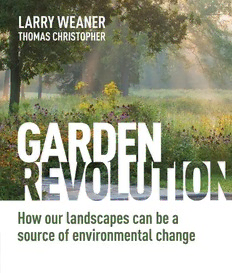
Garden revolution: how our landscapes can be a source of environmental change PDF
Preview Garden revolution: how our landscapes can be a source of environmental change
GARDEN REVOLUTION GARDEN REVOLUTION How our landscapes can be a source of environmental change LARRY WEANER THOMAS CHRISTOPHER TIMBER PRESS PORTLAND, OREGON Page 2: This pond and waterfall were designed to appear as though they were naturally occurring. Page 6: A wasp visits Indian plantain. Copyright © 2016 by Larry Weaner and Thomas Christopher. All rights reserved. Photography and illustration credits appear on page 323. Published in 2016 by Timber Press, Inc. The Haseltine Building 133 S.W. Second Avenue, Suite 450 Portland, Oregon 97204-3527 timberpress.com Printed in China Text design by Debbie Berne Jacket design by Anna Eshelman A catalog record for this book is also available from the British Library. Library of Congress Cataloging-in-Publication Data Names: Weaner, Larry, author. | Christopher, Thomas, author. Title: Garden revolution: how our landscapes can be a source of environmental change / Larry Weaner and Thomas Christopher. Description: Portland, Oregon: Timber Press, 2016. | Includes bibliographical references and index. Identifiers: LCCN 2015036650 | ISBN 9781604696165 Subjects: LCSH: Landscape ecology. | Gardening. Classification: LCC QH541.15.L35 W43 2016 | DDC 577—dc23 LC record available at http://lccn.loc.gov/2015036650 This book is dedicated to my parents, Herb and Elaine Weaner, who each in their own way taught me to think for myself. Outside of their love and support, I have never received a more valuable gift. And of course to Team Weaner: Linda, Jan, Sara, and brother Mark. I love you all very much. —LARRY WEANER To Suzanne, as always. —THOMAS CHRISTOPHER CONTENTS IN THE FIELD 8 Preface by Thomas Christopher 13 Ecological Gardening: An Introduction 172 Weeds and the Ecological Garden 177 Setting the Ecological Process in Motion THE LEARNING PROCESS 208 A Do-Nothing Attitude 215 Creating Meadows and Prairies 26 T he Rise and Fall (and Rise) of a Cardinalflower Patch 254 Growing Pains 31 Influences and Innovators 259 Creating Shrublands 50 The Making of a Garden Star 276 Sedges in the Landscape 57 The Garden Ecologist’s Primer 279 Creating Woodlands DESIGN POSTSCRIPT 86 The Plant That Wants to Be Here 304 Living in It 93 Site Analysis: Where Are You, 305 My House Ecologically Speaking? 114 Reversing Succession 318 Metric Conversions 119 Creating an Ecologically 318 Resources for Garden Ecologists Connected Master Plan 320 Sources and Suggested Reading 322 Acknowledgments 144 Inspiration from Uncle Max 323 Photography and Illustration Credits 149 Developing a Synergistic Plant List 324 Index PREFACE Every book is born of collaborations between writers, editors, designers, and publishers. This book is even more of a collaboration than most. When I met Larry Weaner, I was looking for something more, something new. As a horticulturist, I had become keenly aware that the traditional way of doing things in my field was unsustainable, that much of what I was taught to do during my schooldays was actively harmful to the environment. I wanted my garden to be more than just attractive and fruitful. I wanted it to make a positive contribution to the natural scene around it, to design it so that, in its own modest way, my garden would provide what ecologists call “ecosystem services.” When I heard Larry Weaner speak at one of his annual ecological landscaping confer- ences, I knew I had found my answer. The strategies he laid out promised to make each garden a source of ecological renewal. What’s more, he had the experience to prove his strategies could work. By the time I heard him talk, he had been designing gardens for more than three decades and had hundreds of satisfied clients to attest to the effective- ness of his concepts. Not long afterward, Larry contacted me and suggested that I help him write a book. And so a partnership was born. Relying on my own decades of horticultural experience, I began to pose questions. From the answers, Larry and I began to assemble a text. I con- tributed my own experiences gained from my work with sustainable lawns. In addition, although Larry is an experienced and expert teacher, my own status as a newcomer to Larry’s system of horticulture helped us to identify how to structure the book in a way that was accessible to the average reader. We chose to tell this story in Larry’s voice because it is his story. As I became more involved, however, and began to apply Larry’s insights to my own garden, it became my Neither the hairy alumroot story as well. Our hope is that readers will follow the same path and that this story will on the right nor the become your story, too. As it does, I foresee a time when the collaboration intrinsic to this cardinalflower on the left was planted here. Their presence book will take on a new dimension, and many more gardens and back yards all across is a result of self-proliferation and human landscape North America will make their own contributions to the health and beauty of their local manipulations. ecosystems. That surely is a collaboration, a new partnership, well worth pursuing. —Thomas Christopher 9
